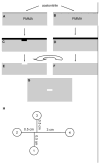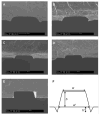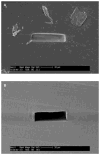Rapid prototyping of poly(methyl methacrylate) microfluidic systems using solvent imprinting and bonding
- PMID: 17466320
- PMCID: PMC3243619
- DOI: 10.1016/j.chroma.2007.04.002
Rapid prototyping of poly(methyl methacrylate) microfluidic systems using solvent imprinting and bonding
Abstract
We have developed a method for rapid prototyping of hard polymer microfluidic systems using solvent imprinting and bonding. We investigated the applicability of patterned SU-8 photoresist on glass as an easily fabricated template for solvent imprinting. Poly(methyl methacrylate) (PMMA) exposed to acetonitrile for 2 min then had an SU-8 template pressed into the surface for 10 min, which provided appropriately imprinted channels and a suitable surface for bonding. After a PMMA cover plate had also been exposed to acetonitrile for 2 min, the imprinted and top PMMA pieces could be bonded together at room temperature with appropriate pressure. The total fabrication time was less than 15 min. Under the optimized fabrication conditions, nearly 30 PMMA chips could be replicated using a single patterned SU-8 master with high chip-to-chip reproducibility. Relative standard deviations were 2.3% and 5.4% for the widths and depths of the replicated channels, respectively. Fluorescently labeled amino acid and peptide mixtures were baseline separated using these PMMA microchips in <15s. Theoretical plate numbers in excess of 5000 were obtained for a approximately 3 cm separation distance, and the migration time relative standard deviation for an amino acid peak was 1.5% for intra-day and 2.2% for inter-day analysis. This new solvent imprinting and bonding approach significantly simplifies the process for fabricating microfluidic structures in hard polymers such as PMMA.
Figures





References
-
- Dittrich PS, Tachikawa K, Manz A. Anal Chem. 2006;78:3887. - PubMed
-
- Unger MA, Chou HP, Thorsen T, Scherer A, Quake SR. Science. 2000;288:113. - PubMed
-
- Becker H, Gärtner C. Electrophoresis. 2000;21:12. - PubMed
-
- Duffy DC, McDonald JC, Schueller OJA, Whitesides GM. Anal Chem. 1998;70:4974. - PubMed
-
- McCormick RM, Nelson RJ, Alonso-Amigo MG, Benvegnu DJ, Hooper HH. Anal Chem. 1997;69:2626. - PubMed
Publication types
MeSH terms
Substances
Grants and funding
LinkOut - more resources
Full Text Sources
Other Literature Sources

